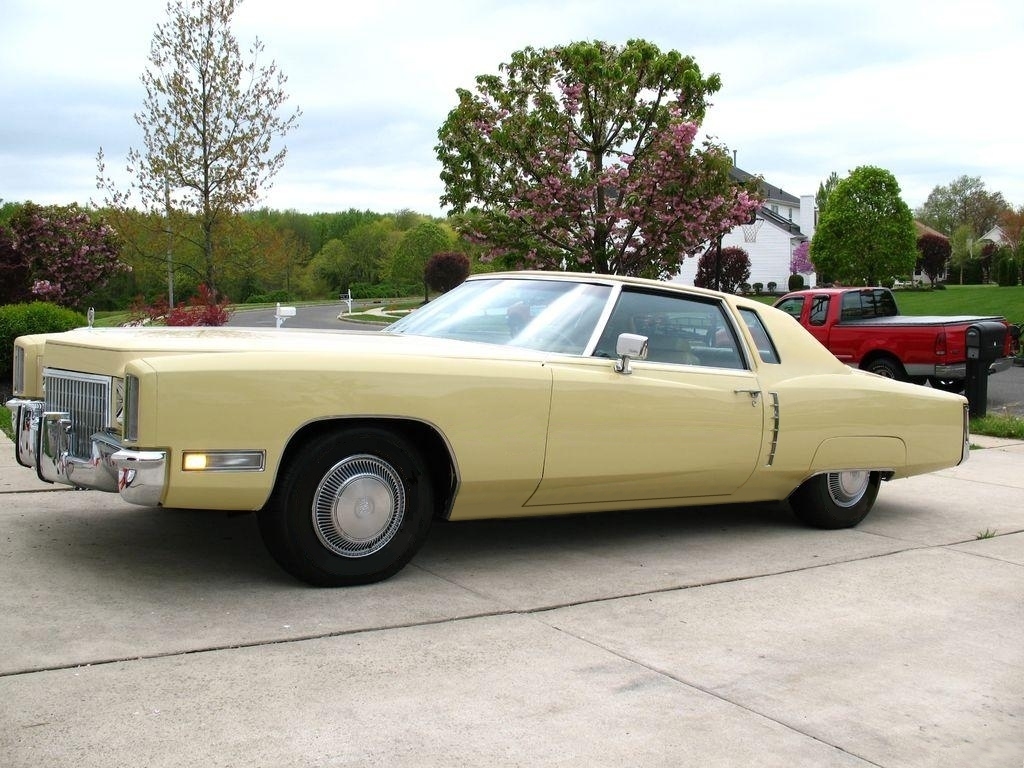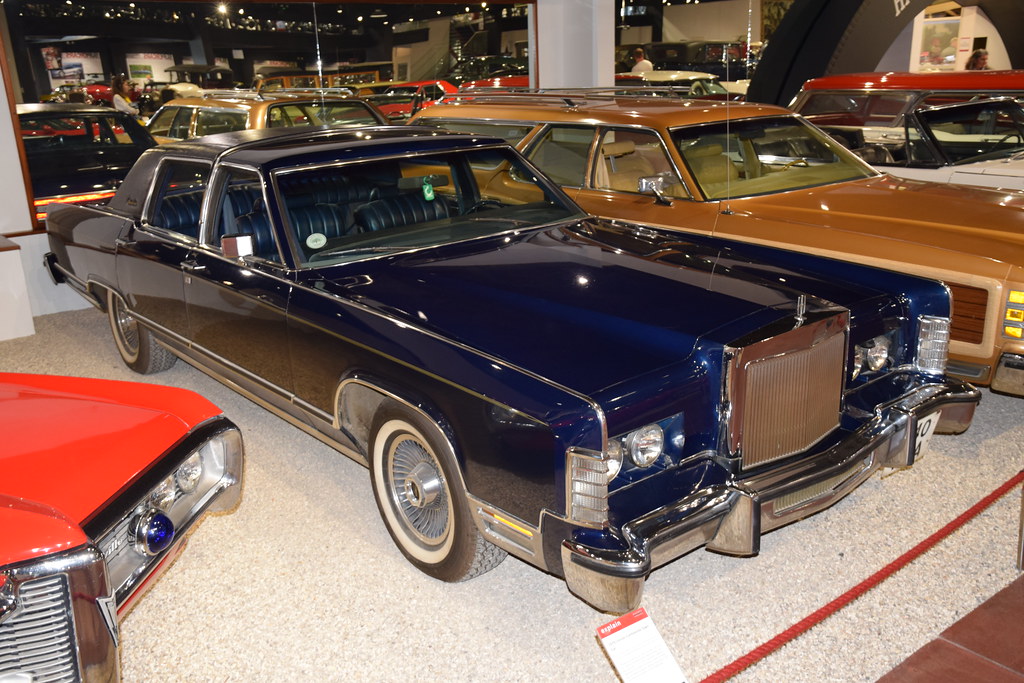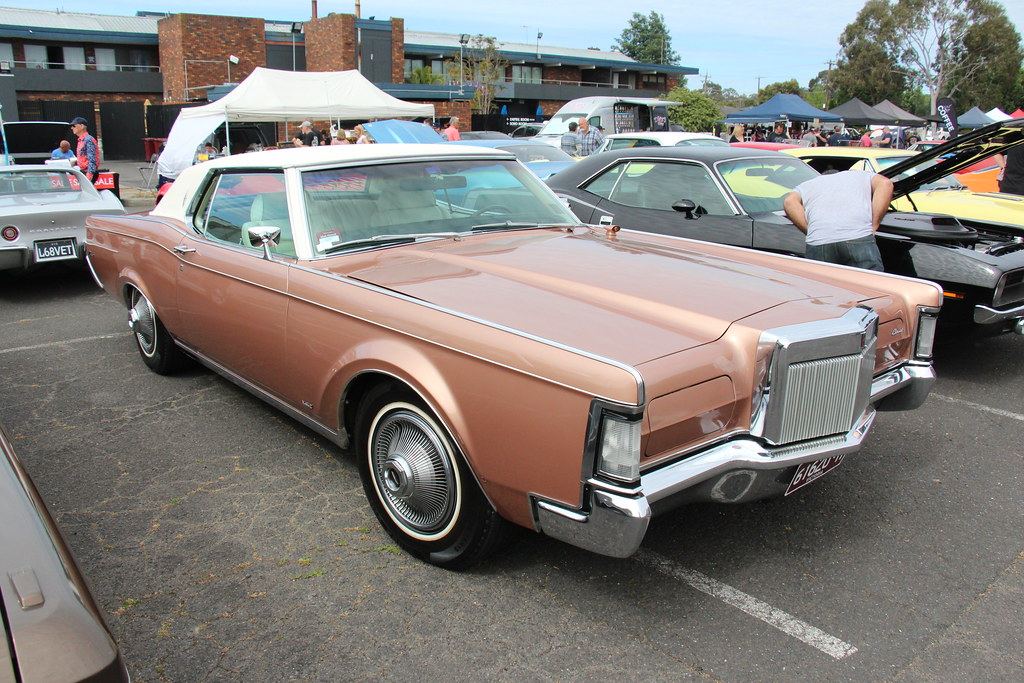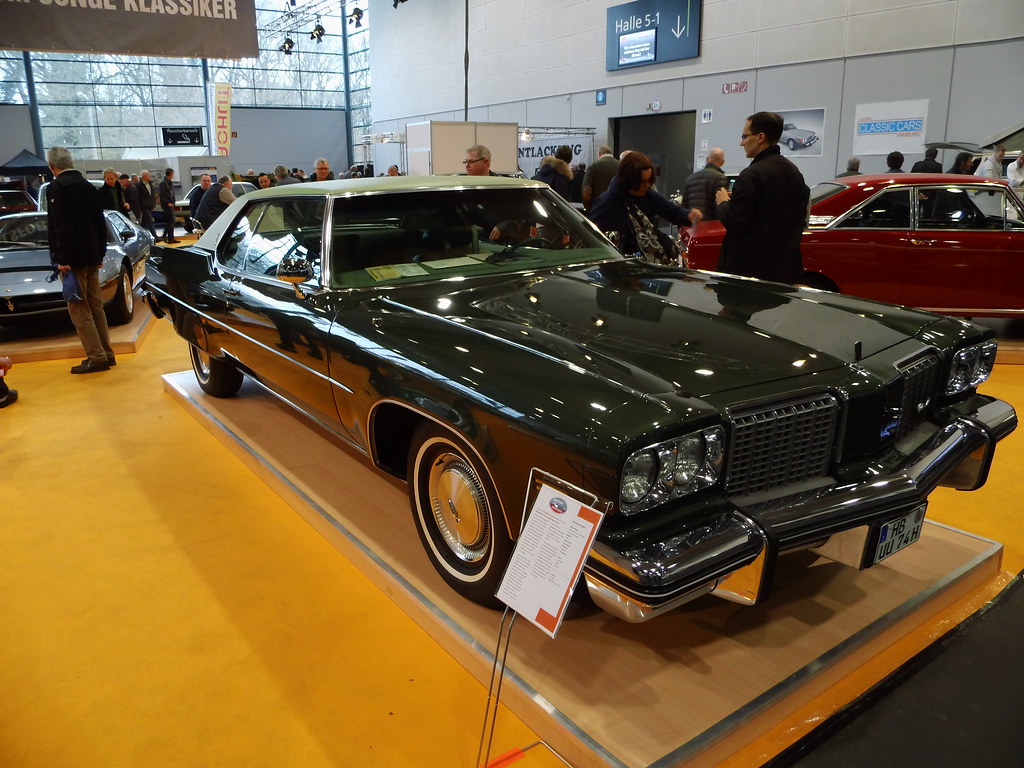
The era of the “land yacht” in American automotive history is a fascinating chapter, a time when bigger was unequivocally better, and cars weren’t just modes of transport but sprawling statements of prosperity and engineering ambition. From the 1960s through to the early 1980s, these giant beasts roamed the highways of America, bedecked in chrome and vinyl, wearing whitewall tyres and powered by huge, lazy engines. They embodied an uncompromising appetite for space, comfort, and presence, delivering a driving experience unlike anything seen before or since.
These colossal machines, often stretching the tape measure to at least 214 inches (5.4 metres) in length, redefined what it meant to be a “full-size” car. They offered interiors that could practically host a small gathering, V8 engines designed for effortless cruising rather than frantic sprints, and designs that prioritized grandeur and road presence above all else. However, what made them symbols of American might back then, paradoxically, makes them largely impractical for the confined, bustling city streets of today, where parking spaces shrink, turning radii are tight, and fuel economy is a paramount concern.
Join us on a nostalgic journey as we unearth some of these magnificent dinosaurs of the automotive world. We’ll explore the first half of our list of behemoths, each stretching to astounding lengths, and delve into the unique characteristics that made them famous, and perhaps, a little too grandiose for contemporary urban environments. Let’s set sail and appreciate these truly American expressions of automotive excess.

1. **1959 Cadillac Series 62**:One simply cannot discuss the zenith of American automotive grandeur without immediately turning to the 1959 Cadillac Series 62. This car was a symbol of American style in the late 1950s, dictating trends and setting benchmarks for luxury and road presence that few could match. Its design, a bold declaration of post-war exuberance, made it an instant icon.
Measuring nearly 225 inches, this Caddy redefined “full-size” and certainly lived up to the “land yacht” moniker. With its massive fins, which were a defining characteristic of the era, the Series 62 presented an imposing silhouette on any road. These dramatic fins, combined with its overall length, ensured it was an unmistakable presence.
Under the hood, the Series 62 was powered by a V8 engine, delivering the kind of smooth, powerful performance expected of a Cadillac. This engine, coupled with its substantial size, made every road feel like a grand boulevard, offering an experience of effortless motoring. It epitomized the idea of cruising in style and comfort.
The interior matched the exterior’s lavishness, an opulent space that could practically hold a small party. This generous cabin space underscored its luxury and allowed for a truly comfortable ride for all passengers. The Series 62 screamed luxury and power, reflecting the affluence and aspirations of its owners, though its sheer scale is a stark contrast to today’s urban practicality.
Car Model Information: 2024 Ford Mustang GT Premium
Caption: 1963 Cadillac Series Sixty-Two Convertible
Name: Cadillac Series 62
Manufacturer: Cadillac
Production: 1940–1942,1946–1964
Predecessor: Cadillac Series 61,Cadillac Series 65
Layout: Front-engine, rear-wheel-drive layout
Assembly: Detroit Assembly,Detroit, Michigan
Successor: Cadillac Calais,Cadillac de Ville series#Third generation (1965–1970)
Class: Full-size,Luxury vehicle#High-end luxury.2Ffull-size luxury cars
Categories: 1950s cars, 1960s cars, Articles with short description, Cadillac vehicles, Cars discontinued in 1964
Summary: The Cadillac Series 40-62 is a series of cars which was produced by Cadillac from 1940 through 1964. Originally designed to complement the entry level Series 61, it became the Cadillac Series 6200 in 1959, and remained that until it was renamed to Cadillac Calais for the 1965 model year. The Series 62 was also marketed as the Sixty-Two and the Series Sixty-Two. The Series 62 was used to introduce the Cadillac Coupe de Ville and the Cadillac Eldorado which started out as special appearance packages that were later placed into production.
Get more information about: Cadillac Series 62
Buying a high-performing used car >>>
Brand: Cadillac Model: Series 62
Price: $48,997 Mileage: 24,328 mi.
Read more about: The Zenith of Chrome and Power: 15 Legendary Cars That Defined the 1950s Automotive Golden Era
2. **1975 Lincoln Continental Mark IV**:The Mark IV Continental embodied the personal luxury coupe of the 1970s, establishing a benchmark for opulent, individualized motoring. Though described as a coupe, its dimensions were more akin to a full-size sedan, challenging traditional classifications. It was a vehicle designed to make a grand statement, prioritizing comfort and presence.
At around 228 inches, it was essentially a mansion on wheels, commanding an impressive footprint on the road. Its distinctive aesthetic included a remarkably long hood, sharp angular lines, and a signature covered spare tire on the trunk. These design elements contributed to its unmistakable profile and underscored its premium status.
The Mark IV wasn’t just a car; it was a statement. Its sheer size and luxurious appointments ensured that if you wanted to feel like you ruled the road, this was the car for you. The driving experience was characterized by smooth, effortless cruising, cocooning occupants in an environment of quiet comfort and stately progress.
While its expansive dimensions provided unparalleled interior space and a plush ride, this same grandeur would present considerable challenges on contemporary city streets. Maneuvering such a lengthy vehicle through congested traffic or attempting to park in a standard urban space would be a formidable task, highlighting the shift in automotive design priorities since its heyday.
Car Model Information: 2024 Ford Mustang GT Premium
Manufacturer: Lincoln Motor Company
Caption: 1975 Continental Mark IV
Name: Mark IV
Production: 1971–1976
ModelYears: 1972–1976
BodyStyle: coupe
Layout: Front-engine, rear-wheel-drive layout
Engine: 460 cuin
Abbr: on
Assembly: Wixom Assembly,Wixom, Michigan
Transmission: Ford C6 transmission
Predecessor: Lincoln Continental Mark III
Wheelbase: 120.4 in
Length: 228.1 in
Width: 79.8 in
Height: 53.5 in
Weight: convert
Successor: Lincoln Continental Mark V
Related: Ford Thunderbird (sixth generation)
Categories: 1970s cars, All Wikipedia articles needing clarification, Articles with short description, Cars discontinued in 1976, Cars introduced in 1972
Summary: The Continental Mark IV is a personal luxury car that was marketed by the Lincoln division of Ford Motor Company from the 1972 to 1976 model years. The third generation of the Mark series, the Mark IV grew in size over its Continental Mark III predecessor. As with the previous generation, the Mark IV saw little direct competition in the American marketplace, competing nearly exclusively against the Cadillac Eldorado (redesigned for 1971).
As with the Mark III, the Mark IV shared its chassis with the Ford Thunderbird, with the Mark IV receiving its own bodywork below the windows. Hidden headlights and a faux Rolls-Royce chrome grille were retained, and a Continental spare tire trunklid. For 1976, the Designer Series option package was introduced; in what would become a tradition for the Mark series (and later Lincoln), the option consisted of specially coordinated exterior and interior trims developed between Lincoln and contemporary fashion designers.
Ford assembled the Continental Mark IV at its Wixom Assembly Plant in Michigan) facility alongside the Ford Thunderbird and the Lincoln Continental. For 1977, the Mark IV underwent a substantial revision, becoming the Continental Mark V.
Get more information about: Lincoln Continental Mark IV
Buying a high-performing used car >>>
Brand: Lincoln Model: Continental Mark IV
Price: $48,997 Mileage: 24,328 mi.
Read more about: The Zenith of Chrome and Power: 15 Legendary Cars That Defined the 1950s Automotive Golden Era

3. **1965 Chrysler New Yorker**:The 1965 Chrysler New Yorker was a definitive example of American automotive muscle and luxury, expertly contained within its considerable 220-inch frame. It was a vehicle built for those who demanded both power and refinement, offering a distinct blend that set it apart in the luxury segment of its time.
Known for its impressive V8 engine, the New Yorker provided robust and reliable performance. This powerful engine worked in harmony with its iconic “Fuselage Styling,” a design philosophy that emphasized smooth, flowing lines and a sense of unified mass, contributing to its imposing yet elegant appearance.
This car provided an ultra-smooth ride, a characteristic highly valued in luxury cars of the era, and offered ample room for all passengers. The focus on comfort and spaciousness made it a preferred choice for long journeys, where passengers could relax in an unconfined environment.
Perfect for anyone who wanted comfort with an extra helping of class, the New Yorker balanced power and sophistication in a big way. However, its substantial dimensions, while ideal for the open highways it was designed for, would undoubtedly prove challenging for today’s tighter urban environments, where agility and compactness are often prioritized.
Car Model Information: 2024 Ford Mustang GT Premium
Name: Chrysler New Yorker
Caption: 1957 Chrysler New Yorker
Manufacturer: Chrysler Corporation
ModelYears: 1940–1942,1946–1996
Class: Full-size
Successor: Chrysler LHS
Layout: FR layout
Categories: 1940s cars, 1950s cars, 1960s cars, 1970s cars, 1980s cars
Summary: The Chrysler New Yorker is an automobile model produced by Chrysler from 1940 until 1996, serving for several decades as either the brand’s flagship model or as a junior sedan to the Chrysler Imperial, the latter during the years in which the Imperial name was used within the Chrysler lineup rather than as a standalone brand.
A trim level named the “New York Special” first appeared in 1938, while the “New Yorker” name debuted in 1939. The New Yorker helped define the Chrysler brand as a maker of upscale models that were priced and equipped to compete against upper-level models from Buick, Oldsmobile, and Mercury.
The New Yorker was Chrysler’s most prestigious model throughout most of its run. Over the decades, it was available in several body styles, including sedan, coupe, convertible, and wagon.
Until its discontinuation in 1996, the New Yorker was the longest-running American car nameplate.
Get more information about: Chrysler New Yorker
Buying a high-performing used car >>>
Brand: Chrysler Model: New Yorker
Price: $48,997 Mileage: 24,328 mi.
Read more about: Remember These? 12 Mind-Blowing Classic TV Car Ads That Vanished From Our Screens (But Live On In Our Hearts!)

4. **1977 Buick Electra 225**:The 1977 Buick Electra 225 earned its memorable nickname, the “deuce and a quarter,” thanks to its approximate 225-inch length. This model stood as the last of the truly huge Buicks before the industry began its trend toward smaller, more fuel-efficient designs. It marked the end of an era for Buick’s grandest vehicles.
This Electra was not merely big for big’s sake; its size was integral to its identity as a luxury cruiser. It packed a potent V8 engine, ensuring a smooth and confident performance on American roads, designed for effortless long-distance travel. The engine’s power complemented the car’s substantial weight, providing a stately ride.
The interior was designed for ultimate comfort, featuring a plush environment that made it ideal for long, luxurious cruises. This commitment to passenger comfort meant expansive legroom, wide seating, and a generally opulent atmosphere, cocooning occupants from the outside world during their journeys.
While its generous dimensions and luxurious features were highly desirable in its time, they present significant challenges for modern urban living. Its substantial footprint would make navigating narrow city streets, performing tight turns, or finding adequate parking spaces a daunting task, underscoring its historical context as a car built for a different landscape.
Car Model Information: 2024 Ford Mustang GT Premium
Caption: 1967 Electra 225 Custom 4-door Hardtop
Name: Buick Electra
Manufacturer: Buick
Production: 1959–1990
Class: Full-size car,Luxury vehicle
Aka: Buick Electra 225
Predecessor: Unbulleted list
Successor: Unbulleted list
Categories: 1960s cars, 1970s cars, 1980s cars, 1990s cars, All Wikipedia articles written in American English
Summary: The Buick Electra is a full-size luxury car manufactured and marketed by Buick from 1959 to 1990, over six generations. Introduced as the replacement for the Roadmaster lines, the Electra served as the flagship Buick sedan line through its entire production and was offered as a two-door sedan, two-door convertible, four-door sedan, and five-door station wagon.
The Electra initially used GM’s rear-drive C Platform, undergoing a significant downsizing for 1977.
For its sixth generation, introduced for model year 1985, the Electra underwent another significant downsizing, and adopted unibody construction as well as GM’s new front wheel drive C Platform — becoming along with its rebadged variants, the Oldsmobile 98 and Cadillac Deville and Fleetwood, the company’s first full-size, unibody, transverse engine, front-drive cars.
For 1991, Buick retired the Electra nameplate, migrating its front-drive premium sedan to the Buick Park Avenue nameplate, previously used as an upper trim level of the Electra itself. The Electra Estate was redesigned, becoming the Roadmaster Estate for 1991.
In late 2022, Buick announced plans to revive the Electra nameplate for its forthcoming 2024 electric models.
Get more information about: Buick Electra
Buying a high-performing used car >>>
Brand: Buick Model: Electra 225
Price: $48,997 Mileage: 24,328 mi.
Read more about: The Duke’s Ride: An In-Depth Look at John Wayne’s Beloved Pontiac Station Wagons and Iconic Automotive Collection

5. **1970 Cadillac Eldorado**:The 1970 Cadillac Eldorado represented a groundbreaking moment for Cadillac, introducing front-wheel drive to a full-size luxury vehicle. This innovative feature, combined with its impressive 221-inch length, contributed to a unique, sleek design and an unparalleled smoothness of ride that distinguished it from its competitors.
This Caddy quickly developed a devoted following among drivers who appreciated its unique balance of power and elegance. The front-wheel-drive system allowed for a flatter floor and more interior space, enhancing the overall luxury experience for passengers. It was truly a sophisticated piece of engineering.
The Eldorado was designed as a full-size car that made even the longest road trips feel like a breeze. Its comfortable ride, coupled with its powerful engine, transformed extended journeys into effortless and pleasurable voyages, solidifying its reputation as a premier touring car.
Despite its engineering innovations and luxurious attributes, the sheer size of the 1970 Eldorado makes it an imposing vehicle for contemporary city streets. Its considerable length and width, once symbols of prestige, now present practical hurdles for urban maneuvering and parking, reflecting the evolution of automotive design towards more compact solutions for congested environments.
Car Model Information: 1976 Cadillac Eldorado Convertible
Caption: 1963 Cadillac Eldorado Convertible
Name: Cadillac Eldorado
Manufacturer: Cadillac
Production: 1952–2002
Layout: Front-engine, rear-wheel-drive layout
Aka: Cadillac Fleetwood Eldorado
Class: Personal luxury car
Successor: Cadillac CTS
Categories: 1960s cars, 1970s cars, 1980s cars, 1990s cars, 2000s cars
Summary: The Cadillac Eldorado is a luxury car manufactured and marketed by the Cadillac Motor Car Division of General Motors from 1952 until 2002, over twelve generations.
The Eldorado was at or near the top of the Cadillac product line. The original 1953 Eldorado convertible and the Eldorado Brougham models of 1957–1960 had distinct bodyshells and were the most expensive models offered by Cadillac during those years. The Eldorado was never less than second in price after the Cadillac Series 75 limousine until 1966. Beginning in 1967, the Eldorado retained its premium position in the Cadillac price structure, but was manufactured in high volumes on a unique, two-door personal luxury car platform.
The Eldorado carried the Fleetwood designation from 1965 through 1972, and was seen as a modern revival of the pre-war Cadillac V-12 and Cadillac V-16 roadsters and convertibles.
Get more information about: Cadillac Eldorado
Buying a high-performing used car >>>
Brand: Cadillac Model: Eldorado
Price: $29,499 Mileage: 31,898 mi.
Read more about: 15 Classic Cars You Might Want To Skip: An Expert Guide for Discerning Collectors

6. **1979 Lincoln Town Car**:At nearly 233 inches, the 1979 Lincoln Town Car is still considered one of the longest sedans ever produced, a true behemoth that dominated American roads. It set the benchmark for luxury sedans in the late 1970s and early 1980s, embodying an era where an expansive physical presence was a defining characteristic of opulence.
This iconic vehicle featured a massive V8 engine, delivering the kind of effortless power and torque needed to propel such a substantial car. Alongside its robust powertrain, it boasted loads of chrome trim, adding to its visual grandeur, and a ride that felt like floating on clouds, emphasizing comfort above all else.
The Town Car became the standard for luxury sedans in its day, offering a blend of stately design and immense interior space. It was unequivocally the car you wanted to be seen in if you valued classic style and ample room for all occupants, making a clear statement about its owner’s discernment.
While its commanding dimensions provided an undeniable sense of luxury, its nearly 20-foot length presents significant practical challenges for modern city streets. Navigating tight turns, fitting into standard parking spaces, or even finding a suitable parking spot would be a considerable undertaking, underscoring the dramatic shift in urban automotive demands.
Car Model Information: 2024 Ford Mustang GT Premium
Name: Lincoln Town Car
Manufacturer: Lincoln Motor Company
Production: 1980–2011
ModelYears: 1981–2011
Class: Full-size,luxury car
Platform: Ford Panther platform
Related: Mercury Grand Marquis,Ford Crown Victoria,Ford LTD Crown Victoria
Layout: Front-engine, rear-wheel drive layout
Predecessor: Lincoln Continental#Sixth generation (1980)
Successor: Lincoln MKT
Categories: 1990s cars, 2000s cars, 2010s cars, All articles with dead external links, Articles with dead external links from March 2025
Summary: The Lincoln Town Car was a model line of full-size luxury sedans that was marketed by the Lincoln division of the American automaker Ford Motor Company. Deriving its name from a limousine body style, Lincoln marketed the Town Car from 1981 to 2011, with the nameplate previously serving as the flagship trim of the Lincoln Continental. Produced across three generations for thirty model years, the Town Car was marketed directly against luxury sedans from Cadillac and Chrysler.
Marketed nearly exclusively as a four-door sedan (a two-door sedan was offered for 1981 only), many examples of the Town Car were used for fleet and livery (limousine) service. From 1983 to its 2011 discontinuation, the Town Car was the longest car produced by Ford worldwide, becoming the longest mass-production car sold in North America from 1997 to 2011. While not a direct successor of the Town Car, the Lincoln MKS would become the longest American sedan until 2016 (overtaken by the Cadillac CT6).
From 1980 until 2007, the Lincoln Town Car was assembled in Wixom, Michigan, (Wixom Assembly) alongside the Lincoln Continental, LS, and Mark VI, VII, and VIII. After Wixom’s closure, Town Car production moved to Southwold, Ontario, (St. Thomas Assembly) alongside the similar Ford Crown Victoria and the Mercury Grand Marquis. The final Lincoln Town Car was produced on August 29, 2011.
Within the Lincoln model line, the Town Car was not directly replaced; the nameplate was used from 2012 to 2019 to denote livery/limousine/hearse variants of the Lincoln MKT. For 2017, the revived Continental replaced the MKS, closely matching the Town Car in wheelbase and width.
Get more information about: Lincoln Town Car
Buying a high-performing used car >>>
Brand: Lincoln Model: Town Car
Price: $48,997 Mileage: 24,328 mi.
Read more about: Remembering a Legend: Burt Reynolds and His 12 Most Iconic Roles That Defined an Era

7. **1961 Imperial Crown Southampton**:The 1961 Imperial Crown Southampton represented a distinct luxury sedan within the Chrysler lineage, carving out an identity all its own. At around 227 inches long, this car boasted unique “gun sight” taillights and an overall aircraft-inspired styling, which gave it a futuristic and commanding appearance on the road.
It was ultra-roomy, with an interior that was richly appointed, emphasizing comfort and sophistication. This generous cabin space was a key selling point, offering occupants a truly spacious and opulent environment during their travels. Every detail contributed to a sense of exclusive luxury.
Further enhancing its top-tier comfort were features like power windows and seats, which were quite a rare sight on the road in 1961. These conveniences underscored its premium positioning and dedication to passenger ease, showcasing the technological advancements of the era.
The Imperial Crown Southampton stood as a testament to American automotive creativity and engineering ambition. However, its impressive length and stately design, while once symbols of prestige, would prove unwieldy for today’s congested urban environments, where agility and compact dimensions are increasingly valued over sheer size.
Continuing our voyage through automotive history with seven more colossal American sedans, we now delve deeper into their opulent features, engineering innovations, and the ultimate factors that rendered these magnificent, outsized cruisers impractical for modern urban driving. These vehicles, much like their predecessors, paint a vivid picture of an era where space and presence were paramount, embodying a distinctive chapter in American automotive design. Let’s explore the next set of these automotive giants, appreciating their grandeur while acknowledging their modern-day limitations.
Car Model Information: 2024 Ford Mustang GT Premium
Name: Imperial
Logo: Imperial chrysler brand logo.png
LogoSize: 150
Type: division (business)
Industry: Automotive industry
Fate: Chrysler Imperial
Predecessor: Chrysler Imperial
Founded: 1955
Founder: Chrysler
Defunct: [object Object]
HqLocationCity: Detroit
HqLocationCountry: United States
Products: Luxury vehicle
Parent: Chrysler
Categories: 1960s cars, 1970s cars, All articles with dead YouTube links, All articles with dead external links, All articles with specifically marked weasel-worded phrases
Summary: Imperial was the Chrysler Corporation’s luxury automobile brand from 1955 until 1975 and again from 1981 through 1983.
The Imperial name had been used since 1926 as a Chrysler luxury model, the Chrysler Imperial. In 1955, the automaker repositioned and launched the Imperial as a separate make and division to better compete with its North American rivals, Lincoln and Cadillac.
The Imperial would feature new or modified body styles introduced every two to three years, all with V8 engines and automatic transmissions, as well as technologies that would later be introduced in Chrysler Corporation’s other models.
Get more information about: Imperial (automobile)
Buying a high-performing used car >>>
Brand: Imperial Model: Crown Southampton
Price: $48,997 Mileage: 24,328 mi.

8. **1976 Cadillac Fleetwood Brougham**:This classic Cadillac stands as an undeniable icon of the “land yacht” era, truly delivering on the promise of space and power in quintessential Cadillac style. Stretching to a hefty 233.7 inches long, the Fleetwood Brougham commanded serious road presence. It was a vehicle designed to make a statement, reflecting the prosperity and taste of its owner.
Beneath its commanding hood lay a powerful V8 engine, ensuring that every journey felt effortless and refined. This engine, combined with its substantial weight, provided a smooth and stately ride. It was engineered for cruising, making long distances feel surprisingly short and comfortable.
Inside, the Fleetwood Brougham offered plush interiors that transformed any drive into a luxurious experience. Owners often felt like they had the road to themselves, cocooned in an environment of unparalleled comfort and quiet. This level of opulence was a hallmark of Cadillac’s top-tier offerings during this period.
While its impressive dimensions and lavish amenities epitomized luxury in the mid-1970s, the sheer scale of the 1976 Fleetwood Brougham presents significant challenges for today’s urban landscape. Navigating tight city streets or finding a suitable parking space for a car of this magnitude would be a formidable task, highlighting the dramatic shift in automotive design philosophies.
Car Model Information: 2024 Ford Mustang GT Premium
Name: Cadillac Fleetwood Brougham
Caption: 1984 Cadillac Fleetwood Brougham d’Elegance coupe
ModelYears: 1977–1986
Manufacturer: Cadillac
Assembly: Detroit Assembly,Detroit,Michigan
Predecessor: Cadillac Sixty Special
Successor: Cadillac Brougham
Class: Full-size,luxury car
Layout: FR layout
Platform: GM C platform (RWD),GM D platform
Wheelbase: 121.5 in
Abbr: on
BodyStyle: Sedan (automobile)
Engine: 250 cuin
Transmission: Turbo-Hydramatic#Super Turbine 400 / THM400 / 3L80 / 3L80HD,Automatic transmission
Length: 221.2 in
Width: 75.3 in
Height: 57.2 in
Weight: convert
Designer: Bill Mitchell (designer)
Related: Cadillac De Ville,Buick Electra,Oldsmobile 98
Categories: 1970s cars, 1980s cars, Articles with short description, Cadillac vehicles, Commons category link from Wikidata
Summary: The Cadillac Fleetwood Brougham is a luxury car manufactured by Cadillac from 1977 through 1986. In 1987, the Fleetwood Brougham name was shortened to simply Brougham, with production continuing through 1992 with only minor updates.
Cadillac used the “Fleetwood” name as a prefix between 1934 and 1976 on several of its most expensive models, always designating an elevated level of luxury. From 1957 until 1961, Cadillac used the “Brougham” sub-designation for its exclusive four-door Eldorado models.
In 1965, the “Brougham” name was first affixed to “Fleetwood” on the Fleetwood Sixty Special as an upgraded option package, which included a vinyl roof and special “Brougham” script lettering on the sides, but it was not a separate model. In 1966, the Fleetwood Brougham was added as a separate model, accompanying the Fleetwood 60 Special, which continued through 1970. In 1971, with the Fleetwood Brougham outselling the Fleetwood 60 Special by a large margin, the two models were consolidated into a single model, the Fleetwood 60 Special Brougham, and would continue with this name through 1976. The car’s name was shortened to Fleetwood Brougham with the 1977 downsizing across the GM car line. The “d’Elegance” and “Talisman” sub-models were also sometimes used to designate upgraded option packages.
Get more information about: Cadillac Fleetwood Brougham
Buying a high-performing used car >>>
Brand: Cadillac Model: Fleetwood Brougham
Price: $48,997 Mileage: 24,328 mi.
Read more about: 15 Classic Cars You Might Want To Skip: An Expert Guide for Discerning Collectors

9. **1969 Lincoln Continental**:No comprehensive list of truly massive American sedans could ever be complete without including the illustrious Lincoln Continental. The 1969 version, stretching to an impressive 224 inches, perfectly encapsulated the brand’s commitment to both spaciousness and sophisticated elegance. It was a car that exuded class and authority in equal measure.
This particular Continental was renowned for its distinctive slab-sided styling, a design choice that lent it an imposing yet graceful appearance. Under the hood, a powerful V8 engine provided the robust performance expected of a luxury vehicle of its stature. This combination ensured a commanding presence on any road.
Stepping inside, one discovered a remarkably roomy cabin, offering ample space for all occupants to stretch out and relax. This focus on interior comfort, coupled with its classic Lincoln grace, made it a preferred choice for those who desired a blend of undeniable luxury and an authoritative road presence. It was truly designed for comfort.
However, the majestic dimensions of the 1969 Continental, while once a symbol of prestige, now pose considerable practical hurdles for contemporary urban environments. Its lengthy wheelbase and wide stance make maneuvering through congested traffic or attempting parallel parking an exercise in precision, underscoring its historical design context.
Car Model Information: 2018 Lincoln Continental Black Label
Name: Lincoln Continental
Caption: 2019 Lincoln Continental
Manufacturer: Lincoln Motor Company
Production: 1939–1942,1946–1948,1956–2002,2016–2020
ModelYears: 1940–1942,1946–1948,1958–1980,1982–2002,2017–2020
Class: Full-size car,luxury car
Layout: Longitudinal engine,Front-engine, rear-wheel-drive layout
Categories: 1930s cars, 1940s cars, 1950s cars, 1960s cars, 1970s cars
Summary: The Lincoln Continental is a series of mid-sized and full-sized luxury cars produced between 1939 and 2020 by Lincoln, a division of the American automaker Ford. The model line was introduced following the construction of a personal vehicle for Edsel Ford, who commissioned a coachbuilt 1939 Lincoln-Zephyr convertible, developed as a vacation vehicle to attract potential Lincoln buyers. In what would give the model line its name, the exterior was designed with European “continental” styling elements, including a rear-mounted spare tire.
In production for over 55 years across nine different decades, Lincoln has produced ten generations of the Continental. Within the Lincoln model line, the Continental has served several roles ranging from its flagship to its base-trim sedan. From 1961 to 1976, Lincoln sold the Continental as its exclusive model line. The model line has also gone on hiatus three times. From 1949 to 1955, the nameplate was briefly retired. In 1981, the Continental was renamed the Lincoln Town Car to accommodate the 1982 seventh-generation Continental. After 2002, the Continental was retired, largely replaced by the Lincoln MKS in 2009; in 2017, the tenth-generation Continental replaced the MKS.
As part of its entry into full-scale production, the first-generation Continental was the progenitor of an entirely new automotive segment, the personal luxury car. Following World War II, the segment evolved into coupes and convertibles larger than sports cars and grand touring cars with an emphasis on features, styling, and comfort over performance and handling. From 1956 to 1957, the Continental nameplate was the namesake of the short-lived Continental Division, marketing the 1956–1957 Continental Mark II as the worldwide flagship of Ford Motor Company; as a second successor, Ford introduced the Continental Mark series in 1969, produced over six generations to 1998.
Along with the creation of the personal luxury car segment, the Lincoln Continental marked the zenith of several designs in American automotive history. The Continental is the final American vehicle line with a factory-produced V12 engine (1948), the final four-door convertible (1967), and the final model line to undergo downsizing (for the 1980 model year).
American production of the Continental and MKZ, its only two sedans, ended in 2020 thereby making Lincoln a crossover/SUV-only brand in the US.
Get more information about: Lincoln Continental
Buying a high-performing used car >>>
Brand: Lincoln Model: Continental
Price: $34,950 Mileage: 45,001 mi.
Read more about: The Zenith of Chrome and Power: 15 Legendary Cars That Defined the 1950s Automotive Golden Era

10. **1974 Oldsmobile Ninety-Eight Regency**:The 1974 Oldsmobile Ninety-Eight Regency was far more than just a car; it truly felt like a VIP room on wheels, offering an unparalleled level of comfort and luxury. Measuring approximately 232 inches long, this sedan was designed to transport its occupants in the utmost style and grandeur.
Its interior was a masterpiece of old-school elegance, featuring plush appointments and notably, luxurious velvet seats. This commitment to lavish comfort created an inviting and opulent atmosphere, making every journey feel like a special occasion. It was a sanctuary from the outside world.
The Ninety-Eight Regency masterfully combined generous space for a crowd with an unmistakably refined style. It was the perfect vehicle for those who valued a luxurious ride imbued with a hint of retro flair, confidently making a statement about its owner’s appreciation for grandeur and comfort. Its size enabled this unique offering.
While its expansive dimensions and opulent features were highly coveted in its heyday, they present significant challenges for today’s tighter urban settings. The sheer length and width would make daily city driving, including navigating parking lots and narrow streets, considerably more difficult than with modern, compact vehicles.
Car Model Information: 2024 Ford Mustang GT Premium
Name: Oldsmobile 98
Caption: 1964 Oldsmobile Ninety-Eight Holiday hardtop coupe
Manufacturer: Oldsmobile
Aka: Oldsmobile Custom Cruiser 98,Oldsmobile 98 (1948–1951),Oldsmobile Ninety-Eight (1952–1956, 1958–1960, 1962–1991),Oldsmobile Starfire 98 (1957),Oldsmobile Classic 98 (1961 only),Oldsmobile Ninety Eight (1992–1996)
Production: 1940–1942,1946–1996
Layout: Front-engine, rear-wheel-drive layout
Class: Luxury vehicle#High-end luxury/full-size luxury cars
Predecessor: Oldsmobile L-Series
Successor: Oldsmobile Aurora
Categories: 1940s cars, 1950s cars, 1960s cars, 1970s cars, 1980s cars
Summary: The Oldsmobile 98 (spelled Ninety-Eight from 1952 to 1991, and Ninety Eight from 1992 to 1996) is the full-size flagship model of Oldsmobile that was produced from 1940 until 1942, and then from 1946 to 1996. The name, referring to a Series 90 fitted with an eight-cylinder engine, first appeared in 1941 and was used again after American consumer automobile production resumed post-World War II. It was, as it would remain, the division’s top-of-the-line model, with lesser Oldsmobiles having lower numbers such as the A-body 66 and 68, and the B-body 76 and 78. The Series 60 was retired in 1949, the same year the Oldsmobile 78 was replaced by the 88. The Oldsmobile 76 was retired after 1950. This left the two remaining number-names to carry on into the 1990s as the bread and butter of the full-size Oldsmobile lineup until the Eighty Eight-based Regency replaced the Ninety-Eight in 1997.
Occasionally additional nomenclature was used with the name, such as L/S and Holiday, and the Ninety-Eight Regency badge would become increasingly common in the later years of the model. The car shared its General Motors C-body platform with Buick and Cadillac.
As it was the flagship Oldsmobile sedan, the Ninety-Eight had the most technologically advanced features available, such as the Hydramatic automatic transmission, the Autronic Eye, an automatic headlight dimmer, and Twilight Sentinel (a feature that automatically turned the headlights on and off via a light sensor and a delay timer, as controlled by the driver), and the highest-grade interior and exterior trim.
In production for 55 years (with a three year hiatus during the war), the Ninety-Eight was one of the oldest passenger car nameplates in the US at the time of its discontinuation in 1996.
Get more information about: Oldsmobile 98
Buying a high-performing used car >>>
Brand: Oldsmobile Model: Ninety-Eight Regency
Price: $48,997 Mileage: 24,328 mi.
Read more about: Timeless Automotive Icons: 10 Cars From the 1940s That Still Command Attention Today

11. **1985 Cadillac DeVille**:Even as the sweeping era of truly massive sedans began its inevitable decline, the 1985 Cadillac DeVille steadfastly upheld Cadillac’s venerable big-car legacy. Measuring nearly 221 inches, this particular DeVille was engineered to deliver a premium experience, even as automotive trends started to shift towards more conservative dimensions.
This model was brimming with premium features designed to enhance comfort and sophistication. Its interior boasted plush seats and tasteful wood trim, creating an atmosphere of refined luxury for all occupants. Under the hood, a V8 engine provided ample power, ensuring performance didn’t skimp on the Cadillac promise.
It expertly catered to discerning drivers who appreciated Cadillac’s timeless design philosophy, presenting it in a more modern, sleeker package for the mid-1980s. The DeVille represented a balance, maintaining a stately presence while attempting to adapt to evolving tastes and priorities in automotive design.
Despite its somewhat more contemporary packaging compared to some earlier land yachts, the substantial size of the 1985 DeVille still poses considerable challenges for today’s urban infrastructure. Its length and width, while smaller than its predecessors, remain unwieldy for compact parking spaces and congested city streets.
Car Model Information: 1964 Cadillac DeVille Base
Name: Cadillac DeVille
Caption: 2004 Cadillac DeVille DHS
Manufacturer: Cadillac
Production: 1958–2005
ModelYears: 1959–2005
Class: luxury car
Layout: FR layout
Predecessor: Cadillac Series 62
Successor: Cadillac DTS
Categories: 1950s cars, 1960s cars, 1970s cars, 1980s cars, 1990s cars
Summary: The Cadillac DeVille is a model name used by Cadillac over eight generations, originally to designate a trim level of the 1949 Cadillac Series 62 and later for a standalone model in the brand range. The last model marketed specifically as a DeVille was the 2005 full-size sedan, at the time, Cadillac’s largest model.
For 2006, the DeVille nameplate was retired, when the model line was carried forward (with minor revisions) as the Cadillac DTS, using a nomenclature adopted by the Cadillac STS and CTS.
Get more information about: Cadillac de Ville series
Buying a high-performing used car >>>
Brand: Cadillac Model: DeVille
Price: $36,000 Mileage: 36,453 mi.
Read more about: The Duke’s Ride: An In-Depth Look at John Wayne’s Beloved Pontiac Station Wagons and Iconic Automotive Collection

12. **1971 Pontiac Bonneville**:The 1971 Pontiac Bonneville was undeniably a beast of a sedan, pushing the very limits of what the term “full-size” traditionally encompassed. Stretching to an impressive 226 inches, the Bonneville was purpose-built to deliver an abundance of both interior space and robust power, setting it apart in its class.
This formidable vehicle was characterized by its wide stance and distinctive, sporty styling, giving it a commanding and dynamic presence on the road. Powering this substantial machine was a serious V8 engine, designed to provide strong, reliable performance for both cruising and more spirited driving.
The Bonneville skillfully combined the best of both worlds: offering plenty of room for all passengers without having to sacrifice its impressive performance capabilities. It was a testament to Pontiac’s engineering, creating a car that was both luxurious and engaging to drive, particularly on open highways.
However, the generous dimensions and significant footprint of the 1971 Bonneville, while appealing for its era, clash dramatically with the practicalities of modern urban life. Navigating narrow city lanes, executing tight turns, or finding adequate parking for such a sprawling vehicle would be a constant struggle today.
Car Model Information: 1964 Pontiac Bonneville
Name: Pontiac Bonneville
Caption: 2000–2005 Pontiac Bonneville
Manufacturer: Pontiac (automobile)
Production: 1958–2005,1983–2005 (Canada)
Assembly: Pontiac Assembly,Pontiac, Michigan
Class: Full-size car
Layout: FR layout
Predecessor: Pontiac Star Chief,Pontiac Executive
Successor: Pontiac G8
Categories: 1950s cars, 1960s cars, 1970s cars, 1980s cars, 1990s cars
Summary: The Pontiac Bonneville is a model line of full-size or mid-size rear-wheel drive (until 1987) or front-wheel drive cars manufactured and marketed by Pontiac from 1957 until 2005.
The Bonneville (marketed as the Parisienne in Canada until 1981), and its platform partner, the Grand Ville, are some of the largest Pontiacs ever built; in station wagon body styles they reached just over 230 inches (5.8 m) long. They were also some of the heaviest cars produced at the time at 5,000 pounds (2,300 kg) or more.
The Bonneville nameplate was introduced as a limited production performance convertible during the 1957 model year, its name taken from the Bonneville Salt Flats in Utah, an early site of U.S. automobile racing and numerous world land speed records.
Get more information about: Pontiac Bonneville
Buying a high-performing used car >>>
Brand: Pontiac Model: Bonneville
Price: $82,999 Mileage: 1,376 mi.
Read more about: Beyond the Legends: 15 Affordable Classic Pontiacs Every Enthusiast Should Consider for Their Garage

13. **1975 Cadillac Coupe de Ville**:Crossing the impressive 230-inch threshold, the 1975 Cadillac Coupe de Ville sails confidently into what can only be described as the “super yacht” category of American automobiles. This magnificent vehicle, a perfect expression of mid-1970s self-indulgence, truly pushed the boundaries of automotive scale.
The interiors of the Coupe de Ville offered unparalleled luxury, with buyers able to choose between rich leather or sumptuously patterned velour upholstery. The exterior was equally grand, featuring a huge vinyl roof and practical cornering lights, designed to assist in steering this impressive ship through the dark.
Adding to its formidable list of features, airbags for both the driver and passenger were available as an option, a relatively rare sight for the time, highlighting Cadillac’s commitment to innovation. Furthermore, optional traction control and classic whitewall striped tyres completed its luxurious and technologically advanced package.
While its commanding physical presence and lavish features were once symbols of ultimate prestige, the immense scale of the 1975 Coupe de Ville makes it an incredibly challenging vehicle for contemporary city streets. Its sheer vastness presents practical hurdles for everyday urban maneuvering and parking, underscoring its historical context.
Car Model Information: 2024 Ford Mustang GT Premium
Name: Cadillac DeVille
Caption: 2004 Cadillac DeVille DHS
Manufacturer: Cadillac
Production: 1958–2005
ModelYears: 1959–2005
Class: luxury car
Layout: FR layout
Predecessor: Cadillac Series 62
Successor: Cadillac DTS
Categories: 1950s cars, 1960s cars, 1970s cars, 1980s cars, 1990s cars
Summary: The Cadillac DeVille is a model name used by Cadillac over eight generations, originally to designate a trim level of the 1949 Cadillac Series 62 and later for a standalone model in the brand range. The last model marketed specifically as a DeVille was the 2005 full-size sedan, at the time, Cadillac’s largest model.
For 2006, the DeVille nameplate was retired, when the model line was carried forward (with minor revisions) as the Cadillac DTS, using a nomenclature adopted by the Cadillac STS and CTS.
Get more information about: Cadillac de Ville series
Buying a high-performing used car >>>
Brand: Cadillac Model: Coupe de Ville
Price: $48,997 Mileage: 24,328 mi.
Read more about: The Zenith of Chrome and Power: 15 Legendary Cars That Defined the 1950s Automotive Golden Era

14. **1973 Imperial LeBaron**:And now, we reach the culmination of our epic voyage through the realm of American land yachts: the 1973 Imperial LeBaron. This monumental vehicle proudly holds the distinction of being the biggest land yacht on our list, and indeed, one of the longest post-war American production cars ever manufactured. Its staggering length was further accentuated in 1973, when federally mandated bumpers added an extra 5.8 inches to its already imposing dimensions.
Regrettably, the peak of the LeBaron’s size coincided with the twilight years of the Imperial brand itself. After 1973, the Imperial nameplate would gradually slip away from the automotive scene, finally being cast adrift for good in 1975. The confluence of oil embargos and increasingly stringent emissions regulations proved to be the decisive factors that ultimately sunk the Imperial.
These external pressures, particularly the soaring fuel prices and the imperative for cleaner engines, would tragically do the same for the rest of the land yacht fleet by the early 1980s. The era of uncompromising size and extravagant power began to wane, making way for a new focus on efficiency and compact design.
The 1973 Imperial LeBaron, therefore, stands not just as a colossus of chrome and steel, but as a poignant symbol of an automotive era that, while magnificent in its ambition, was ultimately unsustainable. Its sheer impracticality for today’s congested, efficiency-minded urban environments serves as a powerful reminder of how dramatically automotive priorities have shifted over the decades.
Read more about: Remember These? 12 Mind-Blowing Classic TV Car Ads That Vanished From Our Screens (But Live On In Our Hearts!)
As we conclude our journey through the annals of these magnificent automotive giants, it becomes strikingly clear that while they represent a glorious, uncompromising chapter in American car design, their sheer bulk simply makes them unsuitable for the demands of today’s city streets. These cars were built for an open road and an era of abundance that has since passed, leaving behind a legacy of audacious luxury and undeniable impracticality for our modern world.



